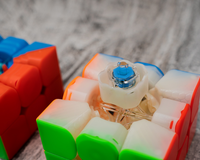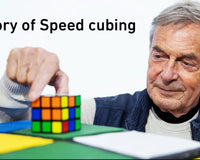In recent times, world records in speedcubing have been reaching an all-time low, which is great in cubing terms because amazing new cubers are solving puzzles in record times much more than in the past. A lot of this improvement is attributed to the way that these cubers set up their cubes, in order to ensure that they obtain the best performance from their puzzles. Believe it or not, maintaining speed cubes is an efficient, economical, and easy way to make sure that your output never dwindles away due to hardware issues.

The maintenance of speed cubes comes down to only a few factors discussed in this blog. The aspects that you need to know about include:
- Lubrication - To ensure the smooth turning performance of the cube and fast execution during solves.
- Tensioning - To ensure stability during solves and minimize the number of lockups while turning.
- Magnet Strength (optional) - To ensure layer alignment based on turning style and find a balance between speed and weight.
Lubrication
Lubricants
Lubricants are the substances that you put in your puzzle in order to enhance its performance in the desired way. Usually, they come in syringe-type tubes and consist of silicone of varying viscosity. That is a new word, but viscosity (in layman’s terms) just means how heavy/thick a certain substance is. Check out Cubelelo’s Standard and Premium Collection of lubricants to see what this looks like.

Cubelelo’s Extensive Lube Collection
Now, the viscosities usually vary from 1 to 5, with 1 being the lightest and 5 being the heaviest. Given below are the viscosities and when you should consider using them.
- Weight 1 (Very Low viscosity) - Cubelelo Hurricane - This is an extremely light silicone lubricant, designed to make your cube as fast as possible. This is usually only used when you need a great boost in the turning speed of your puzzle, and remember to only use it in moderation as too much will make your puzzle uncontrollable.
- Weight 2 (Low viscosity) - Cubelelo Storm - This is also a light silicone lubricant, a bit heavier than weight 1 lubricant, designed to increase the speed of your cube by a little bit. It is also used when you feel that the cube is doing well but slightly slower than desired.
- Weight 3 (Moderate viscosity) - Cubelelo Swift - This is a moderately heavy silicone lubricant, meaning that it is used if your cube just needs smoother turning (not necessarily faster or slower). You should use this when your cube feels dry and requires basic lubrication as it is the safest in the right amounts.
- Weight 4 (High viscosity) - Cubelelo Breeze - This is a heavier silicone lubricant, designed to slow down your cube by a decent amount. This is normally used when your cube is turning fast and you’re unable to control it and can serve as a good moderator for slower turners.
- Weight 5 (Very High viscosity) - Cubelelo Calm - This is the heaviest silicone lubricant which will slow down your cube drastically while providing excess stability. This normally suits cubers who have a slower turning style and perform best on slower cubes. However, be careful not to use it in excess as it will make your cube extremely gummy and slow, making your cubing sessions an unpleasant ordeal.
Watch : Cubelelo Lubricants I First Impression I Ft. Naren Ramesh I Re-Define performance I Cubelelo
How To Lubricate Your Cube
Once you have identified your desired lubricant based on your desired cube performance, you must decide where to apply this lubricant and how much. In general, heavier lubes are applied closer to the core of the puzzle while lighter lubes are applied further out. A good rule of thumb is to put 2-3 drops of your desired lubricant spread out across various layers of your cube.
So, without taking apart your cube completely, you can lubricate it by removing one or two pieces and then reassembling it and ‘breaking it in’, which is the process of doing a lot of turns to ensure that it spreads out evenly across the entire inside of the puzzle. In the case of heavier lubricants, you can put them deeper into the core of the cube in order to ensure good stability and a great feel overall.

Learn: How To Lubricate Your 3x3 Cube | Full Tutorial | Cubelelo
Tensioning

The tensioning of your speed cube is determined by what kind of turner you are. If you turn very quickly and prefer a loose feel, then you would want to tension your cube loosely (turning the screws underneath each centerpiece in the counterclockwise direction). If you turn more slowly and prefer a tighter feel, then you would want tighter tensions (turning the screws in the clockwise direction). Anywhere in between is also okay, but you should ensure that you’re tensioning each face evenly, as described in the next section.
How To Tension Your Cube
Cube tensions are based on the level of tightness that the screws on each face are set to. Generally, a good way to go about tensioning your cube is to make sure that each face is tensioned equally, to ensure uniformity in turning. So, one way to keep that constant is to choose a color order to tension your cube in. For example, I always go White-Yellow to Green-Blue to Orange-Red, thus covering all 6 faces and not missing out on any.

Next, you’ll want to make sure that you’re turning each face by the same amount, and a good way to measure that is by using the design of the screw, which is a plus. Thus, a 90-degree turn is from one spoke of the plus to the next. This way, you can do “quarter-turns” of the screws in the desired direction and ensure that the same angle is turned on the other faces as well. Going in quarter turns is ideal because it doesn’t affect the cube too much and you can set your tensions accordingly, approaching your requirement through small steps.
Conclusion
In conclusion, you can use this blog as a methodical approach to obtaining your ideal cube setup. Remember that it helps to be clear on what you really want before just diving into setting your cube up. Lubrication is to be done as required, and if things go wrong, you can always disassemble your cube, clean it out and reassemble it. Tensioning is to suit your turning style and can affect things such as corner-cutting as well, so you should be careful while doing that.

An interesting debate always comes up when talking about cube setups. Is a performance based on the cube or the cuber? To answer that, it’s essentially a balance between the two. This is because, at a high enough level, it all comes down to how well your cube itself performs, regardless of how efficient your turning is or how well you’re able to solve it. However, the best cubers are capable of producing amazing results on pretty much any cube! So, what are you waiting for? Set up your cube now and watch your times improve drastically!
Watch for More: Tips on Cube Care | Lubrication, Tensioning, Spring Noise | Cubelelo | In Hindi| Rubiks Cube Setup
About Author

Akshaansh Chilakapati
Akshaansh Chilakapati is a speedcuber from Hyderabad who specializes in big cubes. He started cubing when he was 15 and has 5 years of cubing experience. He loves to play sports, music and has a passion for astrophysics. He has attended 20 competitions and won a total of 64 podiums with 16 gold medals. He is also ranked 13th in India for the overall Sum of Ranks (SOR).






























